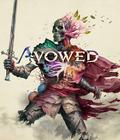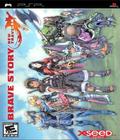An obscure Playstation Portable RPG, released with little fanfare, and based on an anime —sounds like a recipe for disaster, doesn't it? Most of the anime-based RPGs released in the United States have, at best, appealed only to fans, like MS Saga: A New Dawn and at worst, were almost unplayable (Inuyasha: Secret of the Cursed Masked.). So when a game based on the GONZO anime Brave Story is released, it is not something one expects to be good ... and in this case, that would be completely wrong. Brave Story: New Traveler manages to not only be an enjoyable experience for those who've never even heard of Brave Story, but it also manages to be one of the best role-playing titles current available on the PSP.
In many ways, Brave Story: New Traveler resembles an old 16-bit RPG more than the modern day epic storylines that are so prevalent. Brave Story stars a young boy named Tatsuya (although you can rename him), a boy in modern day Japan. He's your average boy in every way; in fact, the first time we see him, he's playing his own PSP. Unfortunately, not long after the story begins, Tatsuya's best friend Miki falls into a mysterious coma that medical science can't explain, and Tatsuya is offered a chance to save her. A mysterious voice offers to send Tatsuya to another world called Vision, where he'll complete a quest to meet the Goddess who created Vision, and he can get a single wish granted. Naturally, he accepts without hesitation and before he can blink, he's transported to Vision, given a sword and some armor and sets out on his quest.
The plot of Brave Story isn't particularly groundbreaking, but the real charm is in the characters, not the plot. Although Tatsuya is a classic "mute protagonist" like Chrono Trigger's Crono or Suikoden's McDohl, he is joined by a number of charming characters on his quest. You first ally, for example, is a bombastic catgirl (or in Brave Traveler's lexicon "kitkin") named Yuno, who generally serves as the mouthpiece for the silent Tatsuya. Your party quickly begins to grow, adding everything from giant lizard men to the protagonist of the Brave Story anime, Wataru. The characters generally don't have long symbolic stories and deep entrenched plot; they're just fun people with whom to travel.
If you've ever played an RPG, you can jump right into Brave Story and grasp most of the mechanics right off the bat. Tatsuya and two other party members battle evil together in turn-based, menu-driven combat. Thankfully, there are a number of mechanics that transform simple combat into something a little more interesting. In the world of Brave Story, Bravura or special techniques run off Brave Points or BP, instead of magic. Brave Points function not unlike MP does in most RPGs, but recovering it is a significantly different task. Every time a character attacks, the party's Bravery meter begins to build. Each attack causes the character to regenerate a few Brave Points, determined by how high the bravery meter is. That means that if your party manages to work out a long combo, you can start busting out special moves and regaining all your BP after each attack. The catch is that if you heal or boost your stats instead of attacking, the Bravery meter resets to zero. It's an interesting mechanic, and one that manages to give you the ability to use special moves often, yet make you think twice about pumping out healing spells every round.
Another fun element is the Unity Attacks, which are powerful techniques that require two or more party members to activate. As your party fights together, the members become closer friends, and once they've battled together for a specific amount of time, they gain the ability to perform a number of Unity Attacks. They're powerful, but they come with a catch: Each member involved has to use BP to activate it, so busting out three Unity Attacks a round is bound to drop your Brave Points to zip in a matter of seconds, unless you're very careful.
However, even outside of Unity Attacks, learning how to make your party work together is to your benefit. When an enemy is killed by a regular attack, there is a chance that the character who defeated them will get a free Extra Attack, which allows him to instantly launch a second regular attack on an adjacent enemy. Of course, if you just let anyone get the kill, your weakest character may be the one to launch the subsequent attack, but with intelligent planning, you can end fights much faster by letting your heavy physical fighters get multiple attacks each round.
Even enemies have specific aspects on which you'll need to keep a close eye because they can severely influence the battle results. Besides the usual elemental strengths and weaknesses, each foe also has a Tribal weakness, which is based on what kind of creature they are. For example, some attacks do extra damage to bug enemies, while others are effective against humanoid enemies. Since enemies can hit fairly hard, learning to use their Tribal weaknesses allows you to beat down tough foes that would normally cause you trouble.
Not all enemies are going to fall so easily, though; some have the potential to go into a Crazed state, which causes them to grow to massive size and make them significantly stronger and tougher to defeat. A neat aspect of the Crazed state is that the enemies drop different items than their calmer counterparts, so it may be in your party's best interest to let them go crazy.
Combat really is as easy or hard as you make it to be. If you do nothing but choose attack, waste BP and wildly flail at enemies, you can probably make your way through the game, but it won't be easy. Likewise, if you master enemy weaknesses, BP conservation and Unity Attacks, you'll find that your life is much easier. Brave Story is no Shin Megami Tensei, but it isn't the kind of RPG where you can just pound the X button and win every fight.
Outside of the main quest, Brave Story offers a number of side-quests to keep your party busy. They're mostly simple tasks (i.e., finding lost items), but the rewards are really interesting. Early on in the story, Tatsuya gets the ability to Craft items, which requires blueprints and materials. Naturally, the best way to get those materials is to perform the side-quests. The one task that really stands out is Goalfinch Brawling, where tiny multicolored birds are pitted against one another in a contest that is as brutal as it is adorable. It's fairly simple and yet oddly addictive, and I found myself spending a lot of time hunting these Goalfinch in an attempt to get the ultimate bird.
Brave Story is one of the best looking games on the PSP. The characters are large, well animated and very expressive. From the twitch of Yuno's ears to the way Tatsuya stares in admiration at Meladee during one of their Unity Attacks, the detail in the characters really does a lot to make them feel alive. Even the enemies share surprising amounts of detail, and when you're fighting identical enemies, they're not always identical. Some are larger or smaller or differently colored, while still technically being the same species of animal. It's a detail that even high-quality RPGs would ignore. Even better, all of this graphical quality comes with some of the best loading times on the PSP. Everything loads in a matter of seconds, and it really improves the overall experience of the game.
Brave Story's aural experience isn't as strong as its visual aspect, but it is certainly not terrible by any means. The music is nice, if completely forgettable, and serves well as background music. Except for a very few specific cut scenes, none of the game's storyline is voiced, which surprisingly isn't too odd and helps to keep things moving as a solid pace. The party (including mute Tatsuya) is voiced in battle, although their vocals are limited to short battle cries. The voices themselves are pretty bland and often sound too fast and unnatural, although with the exception of Yuno, none of the voices get really annoying. Those who prefer can even switch the voices to Japanese, although those also sound like they're trying to rush their lines.
Brave Story: New Traveler isn't innovative; it doesn't bring anything new to the RPG genre, break graphical bounds, create a revolutionary new combat system, or last 80 hours. What it is, however, is fun. Battles are swift and enjoyable, the characters are charming and likeable, the side-quests are interesting and rewarding enough to keep you searching every nook and cranny of the world, and the graphics are among the best on the PSP. If you're an RPG fan with a PSP, you owe it to yourself to give Brave Story: New Traveler a shot.
Score: 8.0/10
More articles about Brave Story: New Traveler












 Brave Story: New Traveler features an entertaining storyline, enjoyable cast of characters and traditional turn-based battle system which is easy to pick up and play even for beginners, but has great depth and innovation for the seasoned gamers.
Brave Story: New Traveler features an entertaining storyline, enjoyable cast of characters and traditional turn-based battle system which is easy to pick up and play even for beginners, but has great depth and innovation for the seasoned gamers.










































